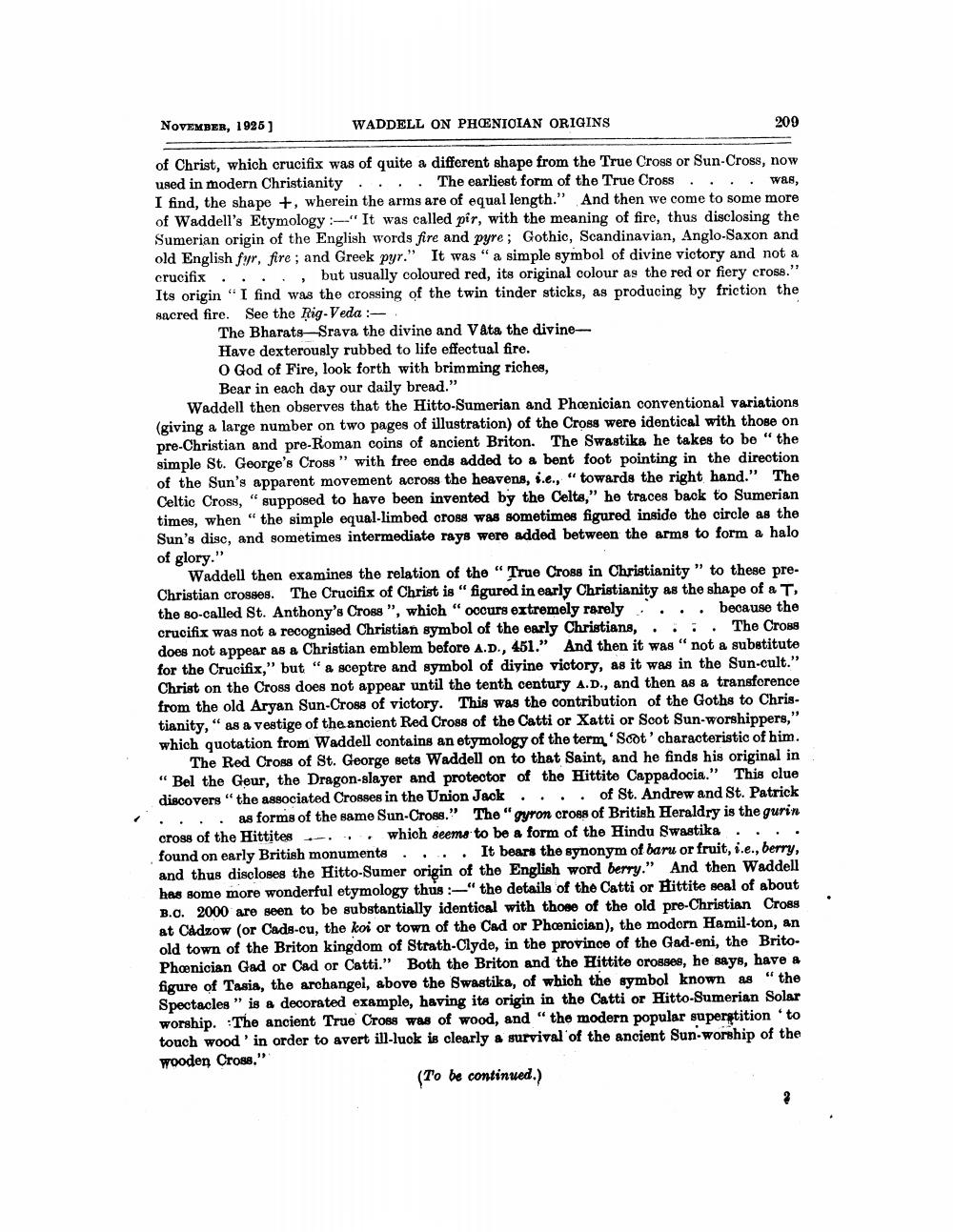________________
NOVEMBER, 1925)
WADDELL ON PHENICIAN ORIGINS
209
of Christ, which crucifix was of quite a different shape from the True Cross or Sun-Cross, now used in modern Christianity .. The earliest form of the True Cross... was, I find, the shape +, wherein the arms are of equal length." And then we come to some more of Waddell's Etymology :-" It was called pir, with the meaning of fire, thus disclosing the Sumerian origin of the English words fire and pyre; Gothic, Scandinavian, Anglo-Saxon and old English fyr, fire; and Greek pyr." It was " a simple symbol of divine victory and not a crucifix ... , but usually coloured red, its original colour as the red or fiery cross." Its origin "I find was the crossing of the twin tinder sticks, as producing by friction the sacred fire. See the Rig Veda :
The Bharats Srava the divine and Vata the divineHave dexterously rubbed to life effectual fire. O God of Fire, look forth with brimming riches,
Bear in each day our daily bread." Waddell then observes that the Hitto-Sumerian and Phoenician conventional variations (giving a large number on two pages of illustration) of the Cross were identical with those on pre-Christian and pre-Roman coins of ancient Briton. The Swastika he takes to be "the simple St. George's Cross" with free ends added to a bent foot pointing in the direction of the Sun's apparent movement across the heavens, i.e., "towards the right hand." The Celtic Cross, "supposed to have been invented by the Celts," he traces back to Sumerian times, when " the simple equal-limbed cross was sometimes figured inside the circle as the Sun's disc, and sometimes intermediate rays were added between the arms to form a halo of glory."
Waddell then examines the relation of the “True Cross in Christianity" to these preChristian crosses. The Crucifix of Christ is " figured in early Christianity as the shape of a T the so-called St. Anthony's Croes", which "occurs extremely rarely ... because the crucifix was not a recognised Christian symbol of the early Christians, .. . The Cross does not appear as a Christian emblem before A.D., 451." And then it was “not a substitute for the Crucifix,” but “a sceptre and symbol of divine victory, as it was in the Sun-cult." Christ on the Cross does not appear until the tenth century A.D., and then as a transference from the old Aryan Sun-Cross of victory. This was the contribution of the Goths to Christianity," as a vestige of the ancient Red Cross of the Catti or Xatti or Soot Sun-worshippers," which quotation from Waddell contains an etymology of the term 'Scot' characteristic of him.
The Red Cross of St. George sets Waddell on to that Saint, and he finds his original in "Bel the Geur, the Dragon-slayer and protector of the Hittite Cappadocia." This clue discovers the associated Crosses in the Union Jack ... of St. Andrew and St. Patrick ...as forms of the same Sun-Cross.” The "gyron Cross of British Heraldry is the gurin cross of the Hittites - , which seems to be a form of the Hindu Swastika ... found on early British monuments ... It bears the synonym of baru or fruit, i.e., berry, and thus discloses the Hitto-Sumer origin of the English word berry." And then Waddell has some more wonderful etymology thus:-" the details of the Catti or Hittite seal of about B.O. 2000 are seen to be substantially identical with those of the old pre-Christian Cross at Cadzow (or Cads-cu, the koi or town of the Cad or Phoenician), the modorn Hamil-ton, an old town of the Briton kingdom of Strath-Clyde, in the province of the Gad-eni, the Brito Phænician Gad or Cad or Catti." Both the Briton and the Hittite crosses, he says, have a figure of Tasia, the archangel, above the Swastika, of which the symbol known as "the Spectacles" is a decorated example, having its origin in the Catti or Hitto-Sumerian Solar worship. The ancient True Cross was of wood, and “the modern popular superstition 'to touch wood ' in order to avert ill-luck is clearly & survival of the ancient Sun-worship of the wooden Cross."
(To be continued.)




